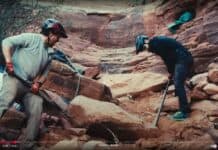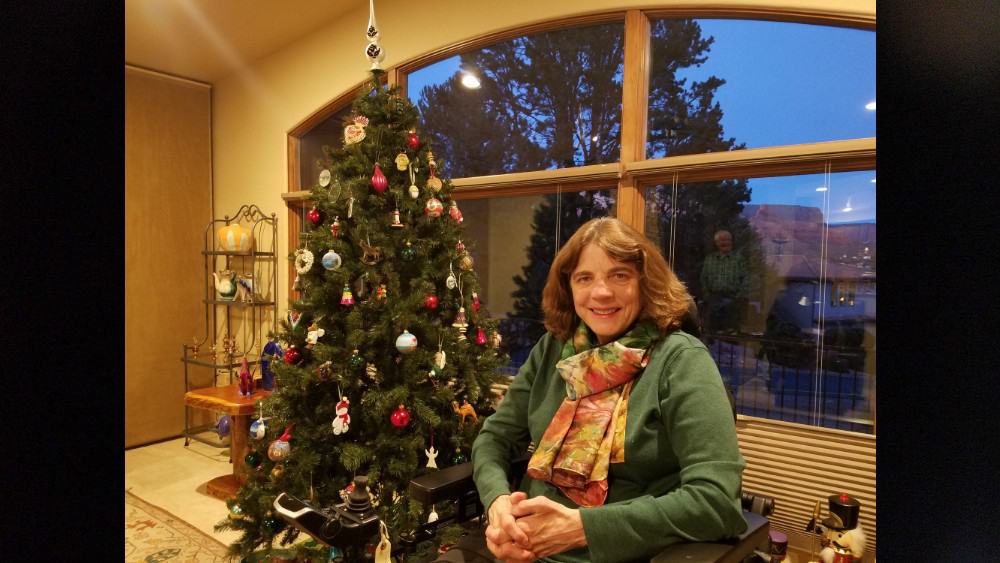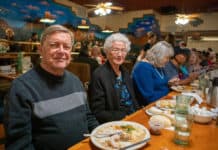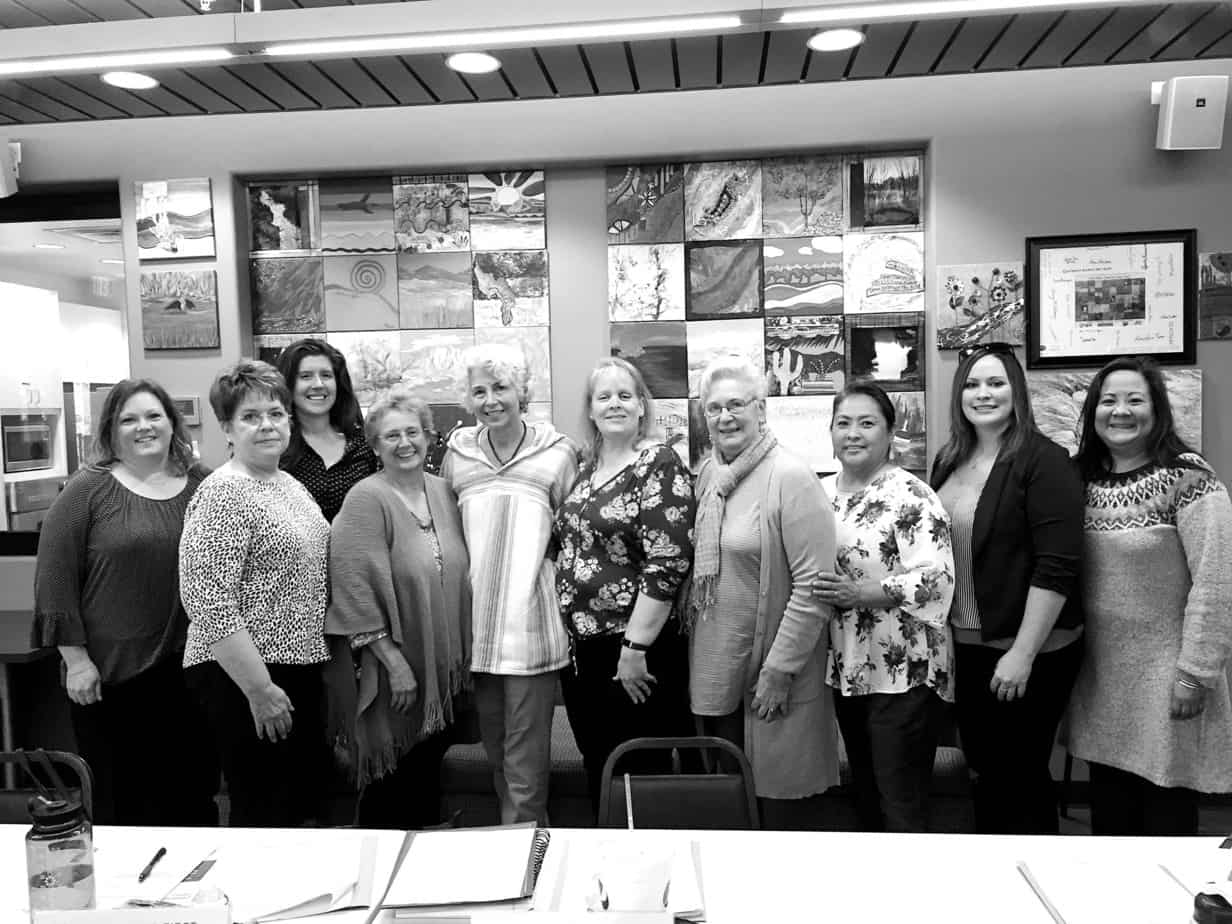Along State Route 89A, where the red rocks tower serenely in the backdrop, passersby might see a flash of red hair — and a colorful scarf — zooming along in the foreground.
In fact, if the traffic’s bad, drivers might even be left in the dust of Helen Ducharme’s red scooter, with its top speed of 8 mph. For some locals, Ducharme has become somewhat of a charming staple on the city sidewalks, often eliciting waves from friends and strangers alike. Ducharme, 63, still conducts errands around her West Sedona neighborhood. She still meets friends for lunch. She still takes advantage of pools when they’re open. And she still enjoys leisure time outdoors, soaking in the scenery that drew her to Arizona in the first place. Some things do remain the same, but life has inexorably changed for Ducharme after an unfathomable diagnosis in 2016.
Amyotrophic lateral sclerosis, also known ALS or Lou Gehrig’s disease, is a degenerative nerve disease that has no known cure. Astrophysicist Stephen Hawking and baseball great Gehrig were notable sufferers. It is Ducharme’s warm presence and day-to-day resilience in the face of this condition that has inspired her friends in Sedona.
A registered nurse for 15 years before earning a master’s degree in New Hampshire and working as a nurse practitioner until retirement at age 57, Ducharme and her husband of 30 years, Mark, moved to Sedona in 2012. After visiting the city up to 10 times and staying longer with each trip, the Ducharmes finally decided to set up shop. Though their accents testify to strong Massachusetts roots, they’re proud to call Sedona home.
“We love it. We always figured that we’d come here after we retired and hike our brains out,” Ducharme said.
When she first came to Sedona, Ducharme became heavily involved with the Sedona Westerners hiking club, attending hikes with nearly every subdivision of the club, from the Mustangs [challenging hikes] to the Trackers [educational hikes] to the Dogies [mellower hikes].
“[Here] it’s rewarding right away. We’d hike forever in New Hampshire, and then it’d be the last 10 feet, and it’s like, ‘oh, here’s the top,’ and we’re practically dead,” Ducharme said, adding that views on Sedona trails aren’t obscured by endless trees like they are back East.
It was while hiking with the Westerners not long after she moved to Sedona that she first noticed something strange with her foot — ignorable at first, but increasingly more of an impediment as time went on. Drop foot, as the phenomenon is called, plagued Ducharme for years, with severe discomfort returning off and on. She couldn’t freely move her foot, and eventually lost all feeling and motion.
Ducharme’s ALS onset was atypical, having affected only one extremity for so long before advancing to other areas; usually, multiple limbs are stricken at one time. Mark Ducharme said that the doctors in the area initially had a tough time giving a proper diagnosis. When it was just her foot affected, many weren’t entirely sure what the cause was. Eventually, Ducharme went to the Arizona campus of the Mayo Clinic, and it was there, after some testing, where she received her diagnosis.
“I went through my various stages, of course. Anger, pity for myself, and occasionally I still lapse back to that, though not so much the anger anymore,” Ducharme said.
“Now [my philosophy] is just do as much as I can and enjoy life.”
As Ducharme became less mobile and more dependent on motorized scooters, she had to give up hobbies like golf — a game she adored for its challenging nature. She also lamented her inability to become immersed in the canyons and the high benches of red rock trails.
Nowadays, in the absence of hiking, Ducharme has furthered herself as an enthusiastic reader and a lover of cinema; she volunteers as a reviewer for the Sedona International Film Festival and recently screened 60 films to gauge their quality. Additionally, she’s joined three knitting clubs. Travel, whether foreign and domestic, remains a huge part of Ducharme’s life.
“We did Yellowstone a year or two ago. I was able to do everything there because everything is wonderfully accessible for handicapped people,” she said.
Though the logistics of the travelling are a bit more complicated these days, she is thankful she can get out and see the world. She has already traveled to most of the continental national parks and forests, which she said are remarkably accessible.
Ducharme said she believes that there’s no reason wheelchair-bound visitors and residents to Sedona can’t experience intimate encounters with the red rocks. Advocating for more handicap-accessible trails in Sedona and the surrounding areas has become the mission of the Ducharmes lately.
“Sedona has nothing,” Mark Ducharme said. “There’s handicap trails down in Cottonwood and Dead Horse Ranch State Park, there’s handicap trails down in Camp Verde and Montezuma Castle, but Sedona has completely nothing and that’s kind of a shame for such a beautiful, upscale community.”
He added that the only trail that comes close is Centennial, but that it doesn’t suffice because it is a quarter-of-a-mile long and runs past a dump, so people are liable to encounter broken bottles and the like.
The Ducharmes have contacted the Red Rock Ranger District, and are now in the process of reaching out to city officials. They said they hope that a trail no longer than 1 mile long that boasts canyon views — or, more generally, “red rock views you can’t get from the roads or sidewalks” — will be selected or created by the city and the RRRD to be made handicap-accessible.
Durcharme suggested Fay Canyon, calling it a “cute” trail reasonably far enough away from noisy roads that would be relatively easy to endow with a handicap boardwalk or pathway of some kind.
In the meantime, Ducharme looks forward to seeing Alaska’s Inside Passage via cruise soon, followed by Denali National Park and Preserve, and still gets excited about the potential of more international trips. But when she’s not planning getaways with Mark, she’s doing what she can to help raise awareness of her disease. In October, she attended an ALS fundraiser walk in Phoenix.
Thanks to her friends in the Sedona Westerners, she was the second-highest-funded participant in the event. Though she can no longer attend hikes with them, Ducharme presides over monthly Westerners meetings as acting secretary.
Ducharme said she makes a point to keep busy, because whenever she has too much down time “things get into her brain” and she thinks too much. She has become involved in ALS support groups, and stays in constant contact with Eric, a fellow ALS fighter in California. Her phone calls with him have helped to keep her positive when storm clouds clutter her mind and the future seems dark.
“He said to me, ‘I want to go out kicking and screaming, I’m going out with my boots on,’ and I said yeah, yeah that’s right,” Ducharme said, all smiles.
Recalling the time she first met Eric in person, Ducharme said, “I got a little morbid and weepy, and he’s like ‘hey, you woke up today, didn’t you? It’s a beautiful day out there, isn’t it?’ and I said, yeah, yeah it really is.”
Ducharme has come to embody this courageous mentality, and her husband said that everyone who crosses paths with her is sure to notice it immediately.





















